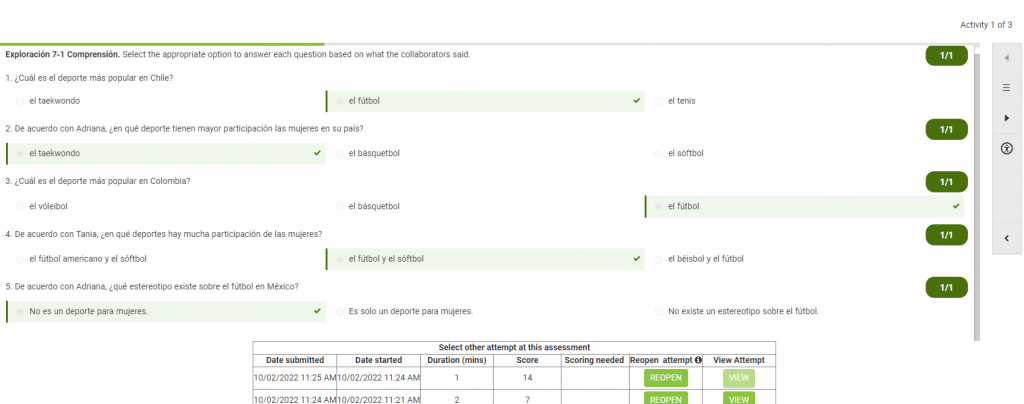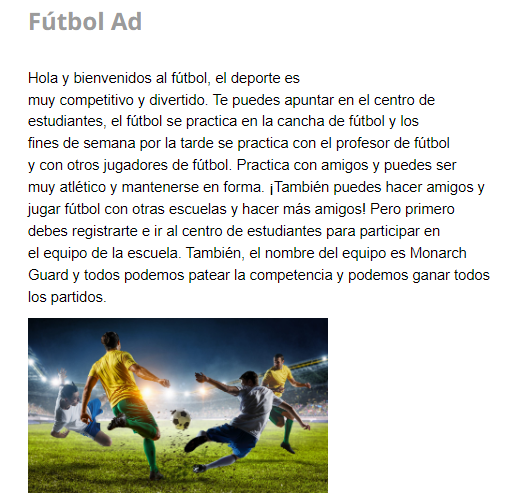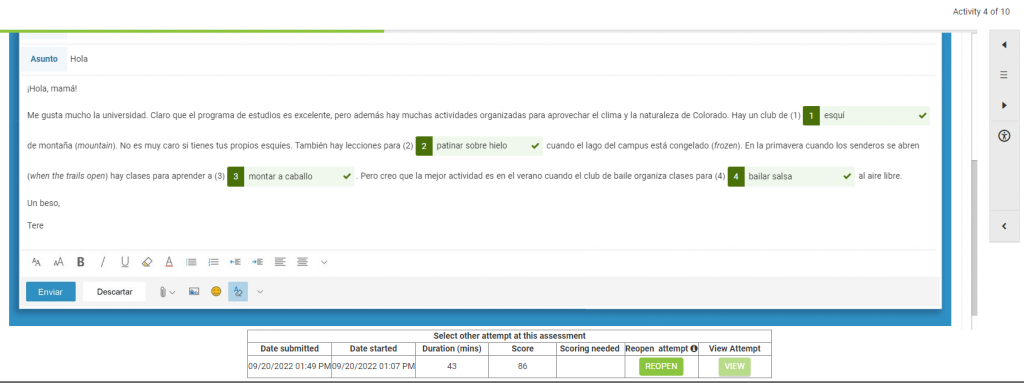Interpretive, Interpersonal, and Presentational Modes of Communication
Exploring Culture
The website and course of LingroLearning and TalkAbroad helped in learning more about the Spanish speaking worlds language and culture. For instance many of the activities found within LingroLearning show the various cultural differences between the U.S. and the many countries of the Spanish speaking world.
One example of these many activities is found in the activity called Exploración cultural, in this activity you answer a series of questions that makes you look into and explore the various cultures for various other countries. In this instance this activities gets you to look at the sports that are being played most and it’s popularity in each country. For example, in Chile the most popular sport in that country is el fútbol or, in English, soccer, where in Colombia the most popular sport there is also soccer but of course there are many other sports that these countries may also enjoy. This activity challenged my worldview in the sense that I thought football here in America would be just as popular in the Spanish speaking world but it seems soccer takes that title. In fact after this I kind of started to believe that soccer was main sport for many other Spanish speaking countries, but they also like other sports such as softball.

Engaging in Communities
I believe that it is very important to engage in every community, so you may have and create an understanding with various different people and find solutions to issues that may be going on within a community.
While I have not yet fully engaged in a Spanish speaking community I would like go to Spanish speaking country and get a better feel for the culture and people in it. I did, however, through the use of TalkAbroad talk with one of these Spanish speakers, and it was really fun and interesting to get to know this person and has definitely peaked my curiosity when it comes to engaging with communities different from my own.
Interpersonal Communication
TalkAbroad is a website where you can talk to Spanish speakers from all across the globe. I personally think that this program or site was rather helpful when trying to practice the oral part of the language and can be of great assistance in both applying and comprehending what you are saying and hearing.
I believe that ever since I have taken not only the LingroLearning and college Spanish courses, but also the TalkAbroad activities or conversations I have improved a lot. Beforehand I would mess up my speech by trying use Spanish words in a certain to show ownership of something much like using the letter ‘s’ after the world along with using the apostrophe before it. This would often look like: “Madre casas” when in reality I should be writing and saying: “Casa de Madre” because there is no apostrophe ‘s’ to show ownership in the Spanish speaking world. Eventually I overcame this difficulty by trying not to think in English while writing or speaking Spanish, which greatly helped. I believe that the thing I excelled most at would be the comprehension part of TalkAbroad, because I would often understand what they were saying, however, because of my difficulty in speaking Spanish I would not be able to get super good construction of a sentence in Spanish. I think I would try and use Spanish more in my daily life and maybe read some of the things I write in Spanish out loud so I can help drill the sentence structure, pronunciation, and various other aspects of speaking Spanish into my head.
Presentational Speaking
In English, give a brief 2-3-line description of any presentational speaking activities you completed this semester inside or outside of class for or related to your Spanish learning. Include a recording of one of these speaking activities. (See Modes of Communication link for description and examples).
For my presentational activities I believe I only did one or two, and I believe that having the words to read from definitely helped ease some of my tension and anxiety. In one of these activities I talked about my family and what everyone in my was like, which was rather fun to present and create.
I believe that this presentation is a good example of my beginnings when trying to speak and present using Spanish. In the video you can hear my various pronunciations of each of the words, and a few mess ups here and there. Eventually I do reach what I was trying to say and move, and this video goes further by showing some of my writing using Spanish. Which is very basic especially considering where I was at that time. However, as time went on in this course my pronunciations and ability to speak Spanish grew and tends to feel a little more natural now. I’d say the biggest challenges I had with presenting in Spanish, would be the pronunciation of words and letters, considering I am once again thinking in English rather than Spanish. I remedied this issue by watching one of my favorite animated tv shows, Gravity Falls, in Spanish where I was able to hear the proper pronunciations for the letters and words that were used in the show.
Presentational Writing
In LingroLearning there were many projects sprinkled throughout the semester for each unit that was discussed, which involved presentational writing of some sort this included a few pamphlet, articles and various other styles of presentations.

In this presentation writing activity which required me to make an ad of sorts whilst using the Spanish language, helped by getting me to use the language and help create a better understanding of syntax in Spanish. I think as time went on through the course it became easier to recall and use certain vocab and correctly conjugate and use certain verbs. Difficulty as stated before was the syntax of some phrases or sentences, such as the use of ownership over something. Again I could not accurately write a sentence without getting the syntax for ownership wrong because I was trying to use the apostrophe ‘s’ when there is no such thing in Spanish. As I mentioned before it simply came down to thinking in English instead of Spanish and to fix that issue I just had to stop doing. One thing I did to remedy this was look at examples of Spanish sentences and write them down whilst saying the sentence out loud as I went along. I think the thing I excelled most at was again recalling information that I needed to accurately conjugate and use verbs for the sentences I was creating and be able to recall the vocab I needed at the moment. I would not really change anything at all and can see how I can do better by using more vocab and maybe longer and more sentences to help exercise my knowledge of writing in Spanish.
Interpretive Listening
There were many activities in LingroLearning that involved you to listen to a conversation that helped with listening comprehension as the course went on throughout the semester.
Unfortunately I do not have any audio or oral examples that can be played to show exactly what activities I did, however, I do have a picture of what these activities would like. These activities would have me click on the volume icon next to the word or play the audio file that they have provided and I would have to answer back with what I think I heard.

I heard many different things throughout this semester, from audio files, conversations, and questions that were being orally asked to me and having answer back by recording and talking back into the microphone. I believe the most challenging parts of listening comprehension would have to be the pronunciation of certain letters and words. This was difficult because the words often sounded really similar and had really subtle differences that would only be heard if the speaker was speaking slower. I overcame this simply by replaying the recording to try and pick out what I am hearing each time. Soon enough I was able to pick up on those subtle differences that I needed to hear in order to distinguish between two similar sounding words and letters. I think the most interesting thing about the oral part of Spanish would be how different each letter sounds when compared to English, not only that but also that the speaking of Spanish tends to have a nice and consistent flow to it and depending on the word has different sounds depending on what letter is being emphasized in the word. I think the main takeaway from this is that the Spanish language has a very nice flow, and does not have the same type of drawn out sound on each letter that English tends to have. I think that through these many activities I have grown quite a bit because now when I listen to something in Spanish I can pick up on what is being said almost immediately or at the very least be able to pick up on some words within a conversation.
Interpretive Reading
There were many different activities within LingroLearning that made you read various conversations in the activity and then have you fill in the blanks of the conversation or you would have to read a question and then answer back with the correct response.

Then, write a short reflection paragraph that includes the activities you described above. What was unclear or challenging for you? How did you overcome this difficulty? What did you find most interesting or compelling? What was your takeaway from the reading? How have you grown with each assignment?
I think what was the most challenging part was trying to figure what exactly to respond with or what to put in the blank space for an activity like this. However, I managed to overcome this challenge by rather than focusing on what I should be responding with or what I think should be in the blank space to make the conversation flow and make sense. I should look at the context of the conversation and from the context find the correct response or find what should be filled or put in that blank space. I unfortunately am not the biggest fan of reading so I did not find many of these activities very interesting or compelling except for the fact that with just the smallest amount of context you can figure out what to respond with or what should be put in place of the blank space to make the sentence or conversation flow consistently. My main takeaway from reading was that if you do not know the context of the conversation you can pretty easily get confused of what is being read and have a somewhat difficult time responding back to someone in a conversation. I believe I have grown with each assignment because while going through each assignment as the course went on I found it far easier to understand and translate in my brain what I am reading and what is being said in the Spanish language.
Just a little side note I tried everything to get my audio file from TalkAbroad onto this page but could not upload it at all for some reason, it just wouldn’t accept a lot of the audio files I was trying to upload into this site.